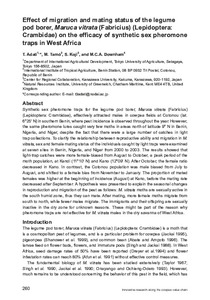| dc.contributor.author | Adati, T. |
| dc.contributor.author | Tamò, M. |
| dc.contributor.author | Koji, S. |
| dc.contributor.author | Downham, M.C.A. |
| dc.date.accessioned | 2019-12-04T11:08:01Z |
| dc.date.available | 2019-12-04T11:08:01Z |
| dc.date.issued | 2012 |
| dc.identifier.citation | Adati, T., Tamò, M., Koji, S. & Downham, M.C.A. (2012). Effect of migration and mating status of the legume pod borer, Maruca vitrata (Fabricius) (Lepidoptera: Crambidae) on the efficacy of synthetic sex pheromone traps in West Africa. In: Proceedings of the Fifth World Cowpea Conference on improving livelihoods in the cowpea value chain through advancement in science, held in Saly: innovative research along the cowpea value chain, (pp. 260-272), 27 Sept. - 1 October, Ibadan, Nigeria. |
| dc.identifier.uri | https://hdl.handle.net/20.500.12478/1696 |
| dc.description.abstract | Synthetic sex pheromone traps for the legume pod borer, Maruca vitrata (Fabricius) (Lepidoptera: Crambidae), effectively attracted males in cowpea fields at Cotonou (lat. 6°25' N) in southern Benin, where pest incidence is observed throughout the year. However, the same pheromone lures caught very few moths in areas north of latitude 9° N in Benin, Nigeria, and Niger, despite the fact that there were a large number of catches in light trap collections. To clarify the relationship between reproductive ability and migration in M. vitrata, sex and female mating status of the individuals caught by light traps were examined at seven sites in Benin, Nigeria, and Niger from 2000 to 2003. The results showed that light-trap catches were more female-biased from August to October, a peak period of the moth population, at Kandi (11°10' N) and Kano (12°09' N). After October, the female ratio decreased in Kano. In contrast, the Cotonou population was male biased from July to August, and shifted to a female bias from November to January. The proportion of mated females was higher at the beginning of incidence (August) at Kano, before the mating rate decreased after September. A hypothesis was presented to explain the seasonal changes in reproduction and migration of the pest as follows: M. vitrata moths are sexually active in the south humid zone, thus they can mate. After mating, more female moths migrate from south to north, while fewer males migrate. The immigrants and their offspring are sexually inactive in the dry zone for unknown reasons. These might be part of the reason why pheromone traps are not effective for M. vitrata males in the dry savanna of West Africa. |
| dc.description.sponsorship | Department for International Development, United Kingdom |
| dc.description.sponsorship | Ministry of Foreign Affairs, Japan |
| dc.format.extent | 260-272 |
| dc.language.iso | en |
| dc.publisher | International Institute of Tropical Agriculture |
| dc.subject | Maruca Vitrata |
| dc.subject | Cowpeas |
| dc.subject | Migration |
| dc.subject | Mating |
| dc.subject | Legume Pod Borer |
| dc.title | Effect of migration and mating status of the legume pod borer, Maruca vitrata (Fabricius) (Lepidoptera: Crambidae) on the efficacy of synthetic sex pheromone traps in West Africa |
| dc.type | Conference Proceedings |
| dc.description.version | Peer Review |
| cg.contributor.crp | Grain Legumes |
| cg.contributor.affiliation | Tokyo University of Agriculture |
| cg.contributor.affiliation | International Institute of Tropical Agriculture |
| cg.contributor.affiliation | Kanazawa University |
| cg.contributor.affiliation | University of Greenwich |
| cg.coverage.region | Africa |
| cg.coverage.region | West Africa |
| cg.coverage.country | Benin |
| cg.coverage.country | Niger |
| cg.coverage.country | Nigeria |
| cg.authorship.types | CGIAR and advanced research institute |
| cg.iitasubject | Cowpea |
| cg.iitasubject | Grain Legumes |
| cg.iitasubject | Pests Of Plants |
| cg.howpublished | Formally Published |
| cg.publicationplace | Ibadan, Nigeria |
| cg.accessibilitystatus | Limited Access |
| local.dspaceid | 82942 |
| cg.targetaudience | Scientists |

